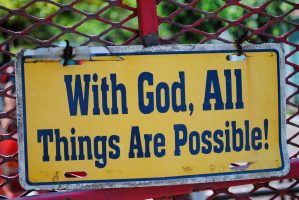
About Us
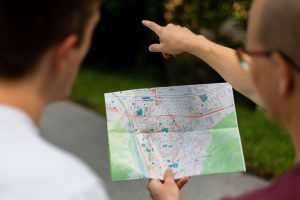
Where Are We?
St. David’s Parish is located in Tea Tree Gully, about 20kms NE of Adelaide, South Australia.
We have a parish church (St. David’s) and a chapel (Our Lady of Hope) in the adjoining suburb of Greenwith.

Contact Us
Parish Office
2 – 4 Vizard Rd
Tea Tree Gully SA 5091
Office Hours
9am – 3:30pm Monday , Wednesday , Thursday , Friday
Closed Tuesday , Saturday , Sunday
Phone
8264 4694
New to the Parish?
Visit the office for a Welcome Pack containing an information card, a Parish Directory and other ‘goodies’.
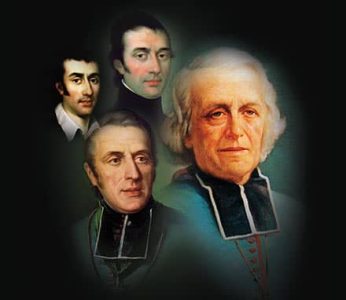
Our Founder – St. Eugene de Mazenod (1782 – 1861)
Charles Joseph Eugène de Mazenod was born in Aix-en-Provence in France in 1782, the son of a wealthy aristocratic parents. His father Charles Antoine de Mazenod, a member of the French nobility was the President of the Aix Parliament. His mother Marie-Rose Joannis, a member of the rapidly evolving bourgeois merchants embodied the practical and shrewd realism of this group. So he came from quite a wealthy background.
He grew up in the years of the French Revolution and his family had to flee into exile in Italy.
Eugene was 20 years old when he returned from exile. Upon arrival in France, his overriding desire was to live fully, to make up for lost time.
Young, handsome, with a well known family name he also had the inherited wealth recovered by his mother. Among his ambitions was to marry a young rich heiress and to secure a prestigious position in society with access to the pleasures and amusements of the good life.
These dreams crumbled one by one starting with the unexpected death of the wealthy young woman. Eugene now 25 years old was forced to make a new balance of his life and person. He was not the extraordinary man that he had imagined himself to be. Certainly, he had some good qualities, a strong character and a generous heart, yet it was also obvious that he had yet to accomplish anything truly important. Superficial friendships and the easy pleasures of high society living were found empty and wanting.
Little by little the social and moral havoc resulting from the French Revolution had profoundly impacted on Eugene. He was moved by the distressing condition of the clergy and the tremendous religious ignorance of the people found everywhere. Endowed with a lively and imperious character and filled with noble intentions, Eugene resolved to play a part in meeting the urgent needs of the Church.
Two interior graces transformed Eugene. The first was a grace of “conversion”. During the adoration of the cross on Good Friday in 1807, Eugene had a special experience of the love and goodness of Christ which culminated in the shedding of his blood to obtain the forgiveness of all sins. Simultaneously conscious of his own sins and filled with a sense of profound confidence in Divine Mercy, Eugene decided to make amends through the total gift of his life to Jesus his Saviour.
A second moment of grace, which he describes as “an impulse from without” from the Spirit, led him to a decision for the priesthood. In 1808, he would enter the Seminary of Saint Sulpice in Paris and be ordained a priest at Amiens, on December 21, 1811. His dream was to be “the servant and priest of the poor”.
In September 1815, he experienced another “impulse from without” that set him firmly on the path of apostolic action. He gave himself body and soul to the realization of his plans to establish a society of missionaries. On January 25, 1816, the society of the Missionaries of Provence was born.
Father de Mazenod invited his companions “to live together as brothers” and “to imitate the virtues and examples of our Saviour Jesus Christ, above all through the preaching of the Word of God to the poor”. He urged them to commit themselves unreservedly to the work of the missions, binding themselves by religious vows. While they initially limited their zeal to the neighboring countryside, their fondest wish, however, was “to embrace the vast expanse of the whole earth”, as the founder had written in 1818.
Its motto: “He has sent me to evangelize the poor” expressed both its charism and way of life.
In his pastoral letters, he emphasises the following points:
- All are called to salvation and holiness. He proposes to the Oblates: “We must strive first of all to lead people to act like human beings, and then like Christians, and finally, we must help them to become saints.”
- To remain on the road to sanctity and make progress, Christians should look upon themselves with the eyes of faith. No matter how poor or destitute they might be, in the eyes of faith all are “children of God”, “brothers and sisters of Jesus Christ” and “heirs of His eternal kingdom.”
- Holiness consists in conversion of heart, fidelity to the law of God and to the inspiration of his grace, in the knowledge and love of Jesus Christ. To love the Jesus Christ is to love the Church.
- The journey to holiness demands a constant ongoing conversion.
Saint Eugene’s spiritual synthesis is found most clearly in the Rules and Constitutions of his Institute. These reflect both his own personal experience and the perception of the needs of the day. When writing the Oblate Constitutions, Saint Eugene borrowed copiously from Sulpician and Jesuit mentors as well as missionaries he admired such as Charles Borromeo, Vincent de Paul and Alphonsus de Liguori.
The Constitutions reflect his unique personality and Gospel rootedness. “The spirit of total devotion for the glory of God, the service of the Church and the salvation of souls is the spirit proper to our Congregation”, he wrote in 1817. He further stated, in 1830, that we must look upon ourselves “as the servants of the Father of a family commanded to succor, to aid, to bring back his children by working to the utmost, in the midst of tribulations, of persecutions of every kind, without claiming any reward other than that which the Lord has promised to faithful servants who have worthily fulfilled their mission.”
In 1832, he was named auxiliary bishop for the Diocese of Marseilles and 5 years later he was appointed Bishop of Marseilles.
Towards the end of his life, Eugene had become very free. Faced with the prospect of becoming a Cardinal which had been promised and which slipped away from him because of political considerations, he had this to say: “After all, it is all the same whether one is buried in a red cassock or a purple one; the main thing is that the bishop gets to heaven”.
Shortly before his death on May 21, 1861, in keeping with his temperament, the elderly and seriously ill bishop said to those around him: “Should I happen to doze off, or if I appear to be getting worse, please wake me up! I want to die knowing that I am dying”.
His last words to the Oblates were a testament that summed up his life: “Practice well among yourselves charity, charity, charity, and outside, zeal for the salvation of souls”.
Eugene died on Tuesday after Pentecost Sunday to the prayer of the Salve Regina. It was his final salute on earth to the one he considered as the “Mother of the Mission”.
Eugene was Venerated on November 19, 1970 and Beatified on October 19, 1975.
He was Canonised on December 3, 1995 by Pope John Paul II.
During the ceremony, the Pope reflected on Eugene with the words:
We are living in the second Advent of the world’s history. Eugene de Mazenod was a man of Advent, a man of the Coming. He not only looked forward to that Coming, he dedicated his whole life to preparing for it, one of those apostles who prepared the modern age, our age.
Eugene de Mazenod knew that Christ wanted to unite the whole human race to himself. This is why throughout his life he devoted particular attention to the evangelisation of the poor, wherever they were found.
By patiently working on himself, he learned to discipline a difficult character and to govern with enlightened wisdom and steadfast goodness. His every action was inspired by a conviction he expressed in these words: “To love Church is to love Jesus Christ, and vice versa”. His influence is not limited to the age in which he lived, but continues its effect on our time.
His apostolate consisted in the transformation of the world by the power of the Gospel of Jesus Christ. What Saint Eugene wanted to achieve was that, in Christ, each individual could become a fully complete person, an authentic Christian, a credible saint.
The Church gives us this great Bishop and Founder of the Oblates of Mary Immaculate as an example of heroic faith, hope and charity.
Text taken from https://www.omiworld.org/our-charism/founder/biography
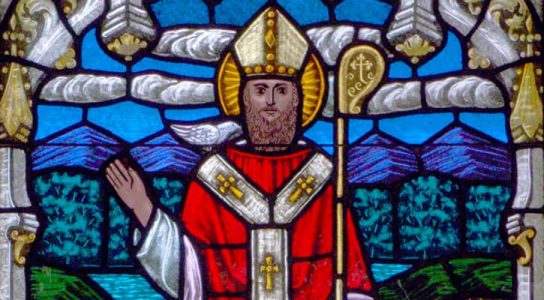
Our Patron – Saint David of Wales (520 – 589)
Our Patron Saint is perhaps the most famous of British saints, yet ironically, we have little reliable information about him.
It is known that he became a priest, engaged in missionary work and founded many monasteries, including his principal abbey in south-western Wales. Many stories and legends sprang up about David and his Welsh monks. Their austerity was extreme. They worked in silence without the help of animals to till the soil. Their food was limited to bread, vegetables and water.
In about the year 550, David attended a synod where his eloquence impressed his fellow monks to such a degree that he was elected primate of the region. The episcopal see was moved to Mynyw, where he had his monastery, now called St. David’s. He ruled his diocese until he had reached a very old age. His last words to his monks and subjects were: “Be joyful, brothers and sisters. Keep your faith, and do the little things that you have seen and heard with me.”
Saint David is pictured standing on a mound with a dove on his shoulder. The legend is that once while he was preaching a dove descended to his shoulder and the earth rose to lift him high above the people so that he could be heard.

Our History
1869
Salisbury Parish established. Tea Tree Gully was included in the boundaries of this new parish.
1941
We became part of Walkerville Parish.
1957
We became part of Hillcrest Parish.
1961
First ‘local’ Mass celebrated in the Tea Tree Gully Institute celebrated by Fr. J. McCann.
1966
Land bought in Elizabeth St, Tea Tree Gully.
There was a house on the land which the priests would live in for a time. The first Presbytery.
1968
Permission given to build a church.
1969
Completed church consecrated by Archbishop Beovich.


1970
First marriage in church.
1973
Archbishop James Gleeson declares St. David’s as a parish in its own right.
Fr. John Dunlea OMI was the first Parish Priest.
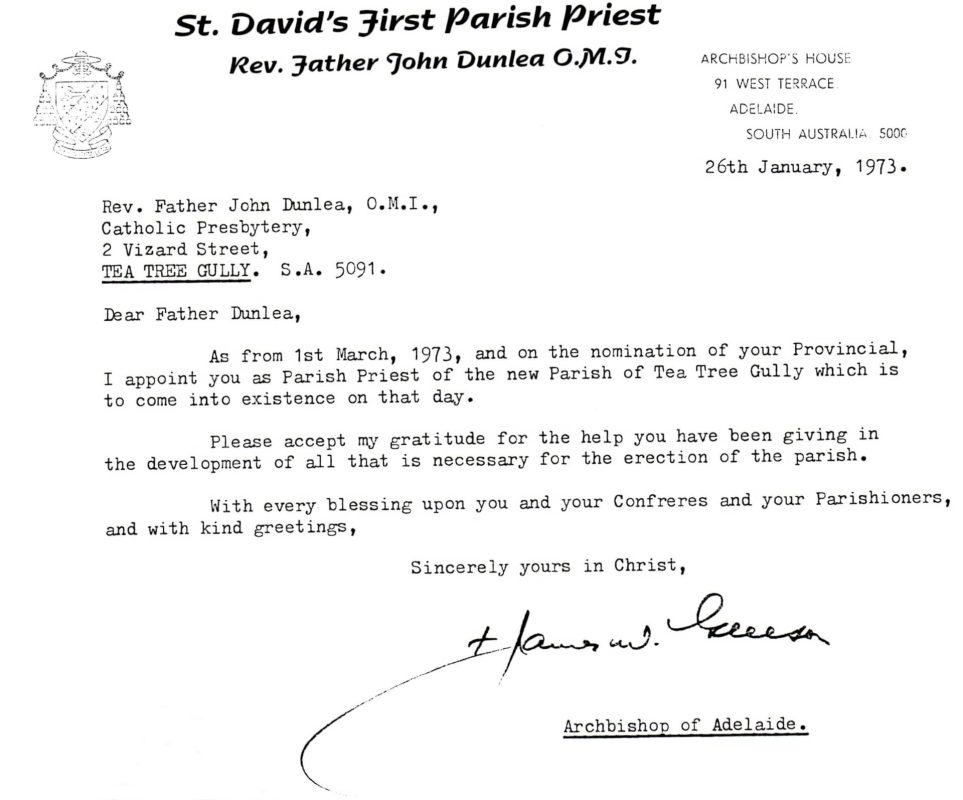
1973
Local branch of the Catholic Women’s League established.
1976
Liturgy Committee established.
1977
St. David’s Parish School opened.
1979
Local branch of the Legion of Mary established.
Work started on the sealing of the Church carpark.
1980
Local branch of the St. Vincent de Paul Society Conference established.
1981
Old Presbytery demolished. Priests moved to a house in nearby Milne Rd.
Construction of new Presbytery started.
First Holy Communion group received.
Dominican Sisters took up residence in a house on Cinnamon Ave, St. Agnes.
1982
Rite of Christian Initiation of Adults (RCIA) established.
First group of Eucharistic Ministers inducted on Holy Thursday.
Domican Sisters leave the parish.
1983
St. Francis Xavier’s Regional Catholic School opened.
Parish Baptism Program begins.
1984
Sisters of St. Joseph move into new Parish Convent on Joycelyn Ave, Surrey Downs.
First St. David’s Antioch weekend held.
1986
Nuns move into house on Vizard Rd.
First Parish Pastorial Council established.
1987
First RE Coordinator for State Schools appointed.
1989
Gleeson College opened.
1993
Construction of Church Foyer commenced.
1994
Blessing and Opening of Parish Centre and Our Lady of Hope Chapel in Golden Grove.
Our Lady of Hope school opened.
1997
St. Eugene DeMazenod Canonisation celebration.
2020
On-line masses broadcast for the first time via facebook and continued throughout Covid 19 lockdowns.
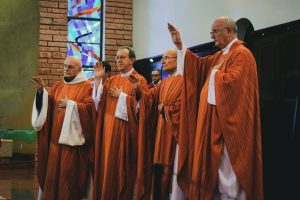
Past Parish Priests
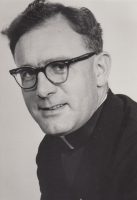
Fr. John Dunlea 1973-79
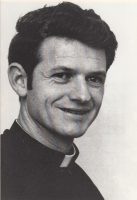
Fr Graeme Crawford 1979-83
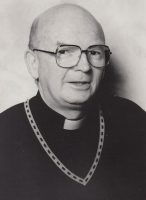
Fr Don Hughes 1983-89
RIP: 20th July 2020
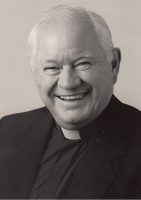
Fr Lewy Keelty 1989-96
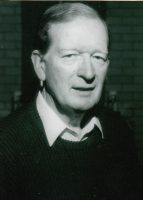
Fr Patrick O’Reilly 1996-2002
RIP: 9th October 2011
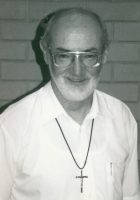
Fr Tony Maher 2002-08
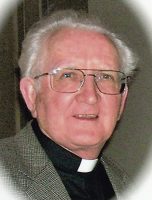
Fr George Ryan 2008-14
RIP: 15th Jan 2016
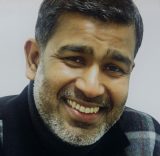
Fr James Jeyachandran 2014-17
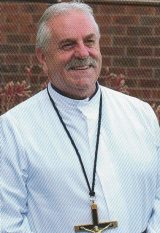
Fr Leo Mifsud 2017-19

Fr James Jeyachandran 2019-






